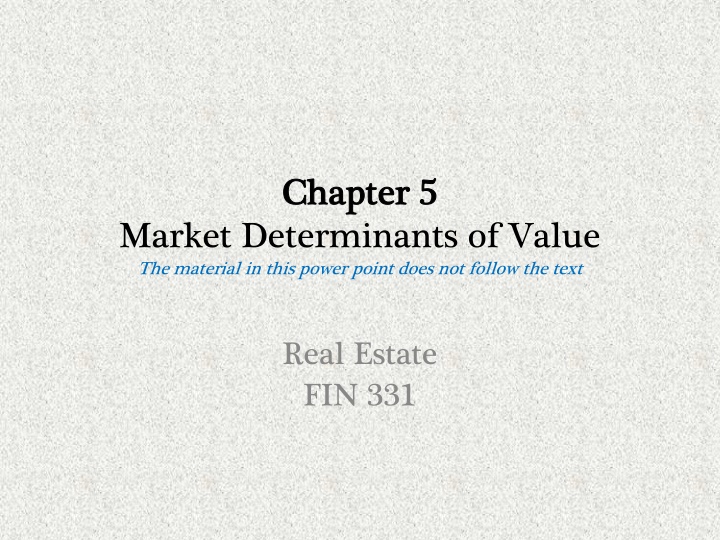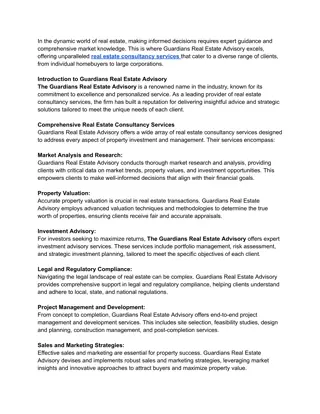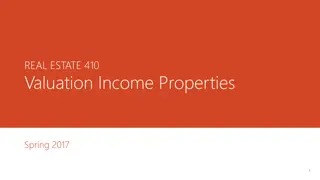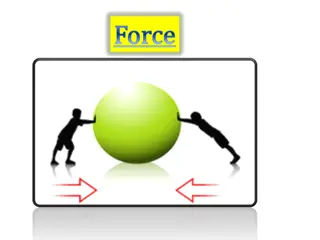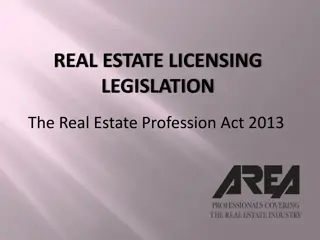Real Estate Market Forces and Value Determinants Overview
This content provides insights into the determinants of real estate value, covering key aspects such as the basic attributes of real property, major forces influencing real estate values (social, economic, physical/environmental, and government), and basic valuation forces related to supply and demand dynamics in the real estate market.
Download Presentation

Please find below an Image/Link to download the presentation.
The content on the website is provided AS IS for your information and personal use only. It may not be sold, licensed, or shared on other websites without obtaining consent from the author.If you encounter any issues during the download, it is possible that the publisher has removed the file from their server.
You are allowed to download the files provided on this website for personal or commercial use, subject to the condition that they are used lawfully. All files are the property of their respective owners.
The content on the website is provided AS IS for your information and personal use only. It may not be sold, licensed, or shared on other websites without obtaining consent from the author.
E N D
Presentation Transcript
Chapter 5 Chapter 5 Market Determinants of Value The material in this power point does not follow the text Real Estate FIN 331
BASIC ATTRIBUTES OF REAL BASIC ATTRIBUTES OF REAL PROPERTY PROPERTY A. A.Five Attributes of Real Estate (land) Five Attributes of Real Estate (land) 1. Unique in location no two parcels are identical in terms of location. 2. Unique in composition no two parcels are identical in their geological composition. 3. Durable land is long-lasting. 4. Finite in supply no more land is being created (reductions in usable land). 5. Useful land has use or utility to people.
Four Major Forces Influencing Real Estate Values A. Social Trends: 1. Trends in population growth and migration 2. Family composition (smaller, delayed formation) 3. Aging of population (downsizing) 4. More people working at home (may be ending) 5. Amenities supporting leisure time (swimming pools, tennis courts, etc.) 6. Security Consciousness (low crime rates, gated communities) 7. Environmental awareness (Energy efficiency, water conservation, recycling)
Four Major Forces Influencing Real Estate Values B. Economic Forces 1. Changes in income levels 2. Availability of good jobs, stable employment opportunities 3. Cost of construction 4. Availability and cost of credit 5. Cost of utilities; electric, gas
Four Major Forces Influencing Real Estate Values C. Physical / Environmental Forces 1. Location, Location, Location! 2. Access to public transportation, infrastructure 3. Topography (rolling hills vs. flat treeless land) 4. Weather (northern vs. southern vs. mid-west vs. southwest vs. Pacific)
Four Major Forces Influencing Real Estate Values D.Government 1. State and Local employment taxes 2. Monetary Policy (effects on interest rates and credit availability) 3. Real Estate Taxes and Assessments 4. Zoning restrictions 5. Quality of schools 6. Availability and quality of services: Police, Fire, Health Care
Basic Valuation Forces A.Supply of and Demand for Properties 1. Supply and Demand tend to be fluid. 2. Supply tends to follow upward price movements 3. Demand trends downward when costs are high 4. Fairness of Valuation tends to clear the markets (interest rates also a factor)
Impact of Risk on Valuation A. Ways to minimize market risk 1. Avoid projects with high market risk a. Most hotels and motels b. Restaurants and entertainment facilities c. Properties in distressed areas 2. Avoid projects with prospective major changes a. Lease rollover for major tenants b. Major renovations 3. Study the macro market environment a. Are there changes in land usage? b. Is the area undergoing gentrification? c. Is industry moving into the area?
City vs. Country A. Cities grow vertically, suburbs grow horizontally B. Cities tend to have higher taxes: city wage taxes, additional sales tax, greater millage rates 1. Some reasons for higher tax burdens: declining industrial activity 2. Unionized municipal employees typically increases cost of municipal services 3. Requirement to operate and maintain city owned transportation (buses, subways)
City vs. Country C. Cities offer better access to convenience services; shops, restaurants, etc. easy walk distance. D.Cities offer greater variety of entertainment venues
Real Estate Valuation Issues A. Some Key Issues 1. Financing 2. Listing 3. Investment Analysis 4. Insurance (Liability, Flood, Windstorm) 5. Property taxes B. Value versus Price 1. Value = present worth of future benefits 2. Benefits of ownership realized over a long period of time
Real Estate Valuation Issues C. Four Elements of Value 1. Demand - the desire or need for ownership supported by the financial means to satisfy the desire; 2. Utility - the ability to satisfy future owners' desires and needs; 3. Scarcity - the finite supply of competing properties and 4. Transferability - the ease with which ownership rights are transferred.
Real Estate Valuation Issues A.Value vs. Cost vs. Price 1. Value is not necessarily equal to cost or price. 2. Cost: out-of-pocket expenses 3. Price: what a person is willing to pay a. Value and Price are not always the same. b. Impact of flaws on price B. Market value 1. Normally the result of an appraisal on a specific date (conditions change all the time)
IRS Issues in re Market Value A. A.IRS Publication 561 IRS Publication 561 1. The governing tax code publication for fair market value of real estate is IRS Publication 561. This publication deals with all kinds of property valuations, such as cars, boats, collections, used clothing, securities, patents, annuities and many others, but it does not set aside a section for determining real estate market value.
IRS Issues (cont.) 2. Publication 561 explicitly states "a detailed appraisal by a professional appraiser is necessary" for proper valuation. 3. Three approaches are considered acceptable by the appraiser: a. the comparable sales approach, b. capitalization of income approach or c. the replacement cost new method.
Homework Assignment A. Key terms: Economic base (p. 102), Comparison activities (p 121) B. Study Questions: 1. List some examples of economic forces. 2. List some examples of social forces. 3. List some examples of environmental forces. 4. List some examples of governmental forces.. 5. List 5 major economic base activities in Wilmington, NC. 6. Using the US Census Web-Site: What is the distribution of income for Wilmington/New Hanover County and North Carolina? Why are there differences in distribution? a. NC: http://quickfacts.census.gov/qfd/states/37000.html b. NHC: http://quickfacts.census.gov/qfd/states/37/37129.html c. Wilmington: http://quickfacts.census.gov/qfd/states/37/3774440.html
